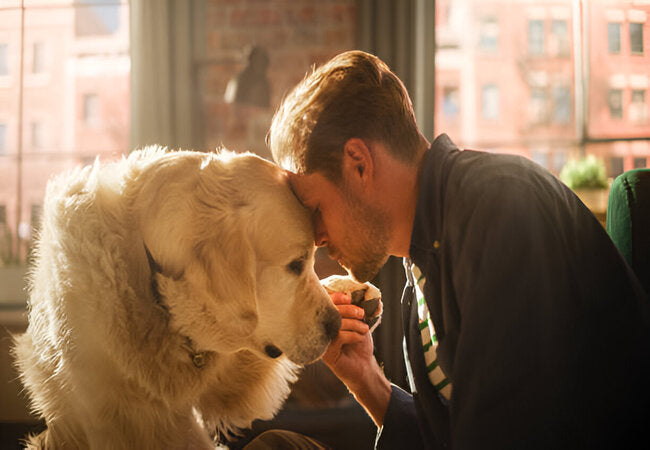How to Heal an Emotionally Traumatized Pet—Vet Guide 2025 🐾

In this article
How to Heal an Emotionally Traumatized Pet—Vet Guide 2025 🐾
By Dr. Duncan Houston BVSc
Pets—especially those rescued from shelters or traumatic backgrounds—may carry deep emotional wounds. These wounds manifest as fear, anxiety, or avoidance, significantly affecting their quality of life. In 2025, veterinarians emphasize a compassionate, systematic approach combining behavior therapy, environment management, medical oversight, and mental enrichment to restore trust and confidence. Here’s a comprehensive guide to healing your traumatized pet with empathy, evidence, and care.
1. Understand What Trauma Looks Like
Traumatized pets often show behaviors like hiding, trembling, avoidance, aggression, or sudden fear responses to everyday events. They may struggle to feel safe or learn new cues—behavior that reflects lingering emotional distress.
2. First Step: Rule Out Medical Issues
Begin with a full veterinary check-up—your pet may be reacting not just to emotional triggers but to pain, infection, or sensory issues. That’s why careful diagnosis is essential before diving into behavior therapy.
3. Gentle Desensitization & Counter‑Conditioning
This is the cornerstone approach:
- Desensitization: Offer controlled, low-level exposure to fear triggers—sounds, sights, environments—without evoking fear.
- Counter‑conditioning: Pair the trigger with highly positive rewards—high-value treats, play, or praise—transforming their emotional response.
Do this gradually—progressive pressure applied too quickly can retraumatize instead of rehabilitate.
4. Build Structure & Safe Spaces
Anxiety thrives on unpredictability. A clear, gentle routine—meals, walks, training, quiet time—helps re-establish a sense of security. Add a calm den-like area stocked with their favorite bed and chews; let your pet choose whether to retreat there.
5. Enrichment & Connection
Activities engaging both mind and body are healing. Puzzles, sniff games, trick training, gentle play, and long walks build confidence and positive emotional experiences.
6. Calming Touch & Gentle Support
Therapeutic bodywork—like the whole energy body balance (WEBB) method—can physically release stress responses in the body and build trust. Tailored massage and gentle touch, when introduced slowly, cue relaxation pathways in your pet’s brain.
7. Consider Medical & Supplemental Support
While behavior therapy is key, medication may be necessary to stabilize severe anxiety:
- Anti-anxiety medications including SSRIs or anxiolytics.
- Supplements like Zylkene or L‑theanine to promote calm focus.
- Pheromone therapy (like Adaptil) to create a soothing environment.
8. Use a Trauma-Informed Approach
Adopt gentle handling—avoid startling or forcing behavioral exposure. Praise and reward trust-building behaviors instead of pushing them too far. Sensory triggers (joey noises, new people) should be introduced on your pet’s terms.
9. Understand Recovery Takes Time
Rehabilitation can span months or years, not days. Programs like the ASPCA Behavioral Rehabilitation Center show that consistent, patient therapy can yield excellent results. For some pets, progress may plateau—yet even small gains in confidence are profound.
10. Professional Guidance & Monitoring
Seek support from veterinary behaviorists or certified trainers—ideally those experienced with trauma. They will help design and monitor a customized, safe, supportive behavior plan.
2025 Healing Action Plan 📋
- 🩺 Begin with a vet wellness exam and pain check
- 📉 Implement systematic desensitization + counter-conditioning
- 🏠 Create calming routines and safe zones
- 🧩 Offer daily enrichment and mental tasks
- 💆 Integrate gentle bodywork for stress relief
- 💊 Use supplemental or prescribed support as needed
- ⏳ Measure progress slowly, adjust methodically
- 👥 Consult professionals for trauma-informed care
Frequently Asked Questions 💬
• Can traumatized pets ever be “normal” again?
While full erasure of trauma is unlikely, many pets learn new healthy routines and can live happy, confident lives with consistent, empathetic care.
• Are medications always needed?
No, but they are often crucial for severe cases—especially in the early stages, to support behavior changes and reduce suffering.
• What if they regress after progress?
Regression is common. It signals sensitivity to new stressors, not failure. Restart gradual desensitization and enrich routine until confidence rebuilds.
• Can I do this alone?
Simple desensitization and enrichment can be started at home. For complex or severe trauma—especially with aggression or self-harm—expert help is strongly recommended.
Conclusion ❤️
Healing a traumatized pet is a journey of empathy, patience, and teamwork. In 2025, the most effective path uses evidence-based behavior methods, environmental stability, purposeful enrichment, calming touch, and medical oversight where needed. With your presence, consistency, and expert partnerships like Ask A Vet, Woopf, and Purrz, your pet can find trust, safety, and renewed joy. 🐾
Need support now? Visit AskAVet.com and download the Ask A Vet app to connect with expert guidance anytime.






